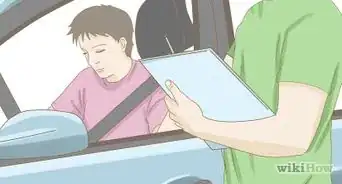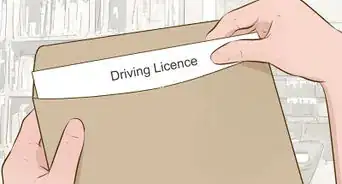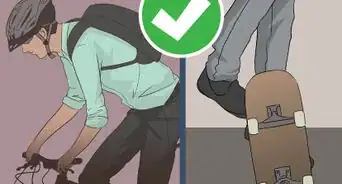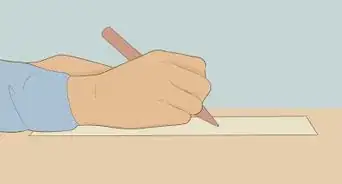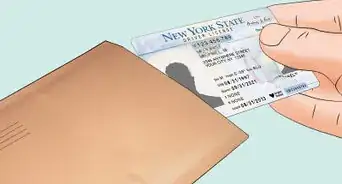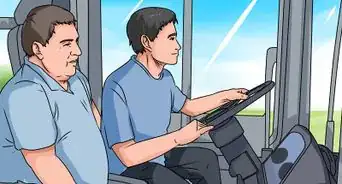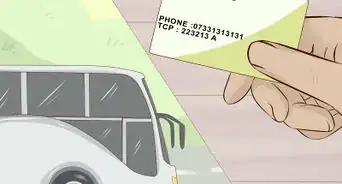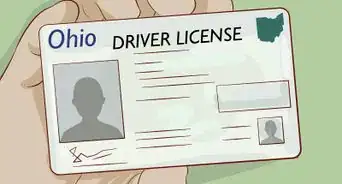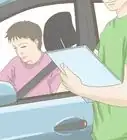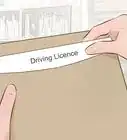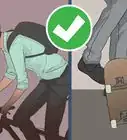This article was co-authored by wikiHow staff writer, Jennifer Mueller, JD. Jennifer Mueller is an in-house legal expert at wikiHow. Jennifer reviews, fact-checks, and evaluates wikiHow's legal content to ensure thoroughness and accuracy. She received her JD from Indiana University Maurer School of Law in 2006.
wikiHow marks an article as reader-approved once it receives enough positive feedback. This article received 11 testimonials and 84% of readers who voted found it helpful, earning it our reader-approved status.
This article has been viewed 450,305 times.
Learn more...
If you want to drive a commercial vehicle in the United States, you typically need a commercial driver's license (CDL). To get a commercial driver's license, start by contacting the state Department of Motor Vehicles (DMV) nearest you. Each state has slightly different procedures and requirements. Generally, you will have to complete a written application, maintain a learner's permit for a period of time, and pass a skills test before you'll be eligible for a CDL.[1] [2] This article provides general information of obtaining a CDL, but remember that every state has its own requirements and this article may not have the information. If you live in Georgia, Massachusetts, New Jersey, New York, or North Carolina, please read the state-specific article on obtaining a CDL.
Steps
Applying for a License
-
1Check your state's eligibility requirements. Federal law requires you to be at least 18 years old to obtain a CDL. However, you must be at least 21 years old to operate a commercial motor vehicle (CMV) in interstate commerce or to transport hazardous materials. You must also provide documentation proving your legal presence in the United States, understand English, and maintain a DOT medical certificate.
- In 49 states and the District of Columbia, you must be 18 years old or older to obtain a CDL. Younger drivers will only be allowed to drive a CMV in the state they live in until they turn 21.
- In Hawaii, you must be 21 years old or older to obtain a CDL regardless if you will only drive in Hawaii.
- The Skills Test must be taken in English. This is because you must be able to read the signs directed at commercial vehicles.
- You cannot have any criminal convictions involving the use of a motor vehicle, for example, human trafficking or you will be ineligible for a CDL.
- You must be legally present in the United States for a CDL. Federal law does not allow states to issue a CDL to those who cannot prove lawful status.
-
2Choose the type of vehicle you want to drive. You must have a CDL to operate large and heavy vehicles with a gross vehicle weight rating (GVWR) or gross combination weight rating (GCWR) of more than 26,000 pounds or any vehicle that transports at least 16 passengers or hazardous materials regardless of size. Your CDL also covers vehicles that you can drive with a general driver's license. The existing classes are:
- Class A: This license authorizes you to operate a vehicle with a Gross Vehicle Weight Rating (GVWR) of 26,001 pounds or more providing the GVWR of the towed vehicle is more than 10,000 pounds.
- Class B: This license authorizes you to operate a vehicle with a Gross Vehicle Weight Rating (GVWR) of 26,001 pounds or more providing the GVWR of the towed vehicle is not more than 10,000 pounds.
- Class C: This license authorizes you to operate a vehicle that is not heavy enough to require a Class A or Class B license, but is used for transporting at least 16 passengers (including the driver) or hazardous materials requiring placards.
Important: The requirement for a Class A CDL to tow a trailer over 10,000 pounds varies by state, so research the specific regulations in the state where you plan to tow to ensure compliance with the law. In some states, you can tow a trailer over 10,000 pounds without a Class A CDL as long as the combined weight of the truck and trailer is not over 26,000 pounds, but in other states, a Class A CDL is required regardless of the combined weight.
Advertisement -
3Get a copy of your state's CDL manual. If you want to pass the knowledge tests, you must read the manual. It is available in English and Spanish in many states, and can be read online or picked up in any office. You may also study using practice questions online, but the DMV will likely re-word them or create new questions as a strategy to keep those who didn't read the book from passing so your best bet is to just read. [3]
-
4Complete your CDL application. Your state has a specific form you must complete if you want to apply for a CDL. You may be able to download this form online and complete it ahead of time. Many states require you to fill out the form in person at the DMV.[4]
- You may have to bring documentation to prove parts of the application. Read the instructions carefully and look through the entire document once before you start filling it out.
- Part of your CDL application will be a 10-year history record check. You must provide information regarding all other states in which you were licensed to drive, including the dates you lived there and your legal address.[5]
Getting Your Learner's Permit
-
1Gather required documents. To apply for a CDL, you must bring identification, proof of citizenship status, and proof of residency. Beyond these documents, other medical certifications or background documentation may be required, depending on the type of license and endorsements you need.[6]
- Check with the local DMV or visit your state DMV's website to find out exactly what documents you need to bring with you. If you have any questions about whether a particular document will work, call the DMV and ask. Having all the right documents will save you a lot of time.
- All states charge fees for issuing a CDL. You may be required to pay all fees at once, or you may have to pay individual fees at separate times. For example, you may pay the application, written test, and permit fee all at once, then pay the skills test and license fee later.
-
2Turn in your CDL application. Turn in your application along with all required documents in person at your local DMV office. If you live in a larger metropolitan area, find out if you can schedule an appointment so you don't have to wait as long.[7]
- You must bring documents that prove your identity and your residency. Different states may accept different types of documentation to prove residency. Check with your local DMV. There typically will be a list of accepted documents on their website.
- Some states, such as California, require you to schedule an appointment if you're applying for a new CDL.
-
3Pass the written test. Before you can get your CDL permit and start driving a commercial vehicle, you need to demonstrate knowledge of the rules of the road. All CDL applicants take a general written test.[8]
- Some endorsements, such as those for driving a school bus or transporting hazardous materials, may require you to take an additional written test.
- Once you've completed your test it will be scored immediately. If you earn a passing score, you'll be issued your permit. If you don't pass, find out what you can do to retake the test. Keep in mind you may have to pay an additional fee to retake the test.
-
4Start the TSA background check process. If you plan to drive across state lines, or will be transporting hazardous materials, you may be required to complete a background check with the federal Transportation Security Administration (TSA).[9]
- You can schedule an appointment with a TSA agent online at https://universalenroll.dhs.gov/, or you can call 1-855-347-8371.
- There is a fee for the TSA background check. You also will have to be fingerprinted.
-
5Complete the theory portion of Entry-Level Driver Training. If you will upgrade your driver's license to a Class A or Class B, you must complete the theory portion of Entry-Level Driver Training (ELDT). You will sit for a lecture that will teach you how to operate and maintain a commercial motor vehicle safely followed by a short test at the end to show you understood the material. This can be completed online or at any driving school as long as the company is approved by the TPR.
-
6Complete the behind-the-wheel training of Entry-Level Driver Training. You will learn how to operate a commercial vehicle, including how to park the truck or bus, how to make wide turns, and how to respond to certain situations. If you successfully complete both the theory portion and behind-the-wheel training, you will be given a certificate of completion which will allow you to take the skills test.
- The certificate does not expire, so you do not need to complete ELDT again even if your commercial learner permit expires and you renew unless you upgrade to Class A or obtain a Passenger, School Bus, and/or Hazardous Materials endorsement.
Getting Your Full License
-
1Schedule your CDL skills test. Once you've gotten enough practice in and feel comfortable behind the wheel, look into taking the skills test necessary to get your full license. Keep in mind that you may not be able to schedule an appointment for several months.[10]
- To pass your Skills Test, you must be able to inspect your truck or bus for potential defects and the engine compartment, including an Air Brake check. You must also demonstrate you can reverse and drive the truck or bus. The information is available in your CDL handbook (Sections 11 to 13).
- Many states require you to drive on your permit for a certain period of time, typically at least two weeks. Some states also may require you to log a certain number of hours driving on your permit before you can schedule your skills test.
- In some states, you may be able to use a third-party examiner service. Staff at the DMV will tell you if this option is available, or you can check the state DMV's website.[11]
-
2Pass your CDL skills test. Before you can get a full CDL, you must pass a driving skills test with a licensed examiner. The skills you will be tested on depend on the type of vehicle you're driving and the operations you will commonly perform.[12]
- You must take the CDL skills test in the exact vehicle that you will be driving. This includes transmission and air brakes. For example, if you're going to be driving a vehicle with a manual transmission, you must take your skills test in a vehicle with a manual transmission.
- If you don't get a passing score on your skills test the first time around, you may be able to retake it. For example, in California you can take the CDL skills test up to three times. Ask your examiner about your options.[13]
-
3Receive your CDL. Your examiner will issue your CDL after you pass the skills test. Each state varies regarding when and how you will receive your official CDL. In some states you can come into the DMV office and pick it up the next day. Others mail it to you.[14]
- When you get your CDL, check over it carefully to make sure all the information on it is correct and your name is spelled correctly. Get any errors changed immediately or they could cause you problems later on.
- Keep in mind that federal regulations no longer permit states to issue temporary CDLs, so you may have to wait a day or two before you can begin work.[15]
Community Q&A
-
QuestionCan someone with type 2 diabetes get a CDL?
 Community AnswerYes. Unless you have a disabling medical condition that interferes with your hands, feet or eyes, making you unable to preform the tasks of a Certified Driver, you can get a CDL.
Community AnswerYes. Unless you have a disabling medical condition that interferes with your hands, feet or eyes, making you unable to preform the tasks of a Certified Driver, you can get a CDL. -
QuestionHow many questions are on the CDL permit test?
 Community AnswerIt depends on what test you are going for. General knowledge can be about 50 questions, and specific areas (Hazmat, Tanker, Air Brakes, etc.) can be about 25.
Community AnswerIt depends on what test you are going for. General knowledge can be about 50 questions, and specific areas (Hazmat, Tanker, Air Brakes, etc.) can be about 25. -
QuestionWill I have to learn to drive on a manual shift or are there trucks with an automatic transmission?
 Community AnswerThere are commercial vehicles with automatic transmissions, but from experience, it's a lot safer and easier to learn to use a manual transmission.
Community AnswerThere are commercial vehicles with automatic transmissions, but from experience, it's a lot safer and easier to learn to use a manual transmission.
References
- ↑ https://www.fmcsa.dot.gov/registration/commercial-drivers-license/how-do-i-get-commercial-drivers-license
- ↑ https://www.fmcsa.dot.gov/registration/commercial-drivers-license/entry-level-driver-training-eldt
- ↑ https://www.fmcsa.dot.gov/registration/commercial-drivers-license/how-do-i-get-commercial-drivers-license
- ↑ http://www.dol.wa.gov/driverslicense/cdlsteps.html
- ↑ https://www.dmv.ca.gov/portal/dmv/detail/dl/dl_info#CDL
- ↑ https://www.fmcsa.dot.gov/registration/commercial-drivers-license/how-do-i-get-commercial-drivers-license
- ↑ https://www.dmv.ca.gov/portal/dmv/?1dmy&urile=wcm:path:/dmv_content_en/dmv/dl/dl_info#CDL
- ↑ https://dmv.ny.gov/get-cdl
- ↑ https://www.dmv.ca.gov/portal/dmv/?1dmy&urile=wcm:path:/dmv_content_en/dmv/dl/dl_info#CDL
- ↑ https://www.fmcsa.dot.gov/registration/commercial-drivers-license/how-do-i-get-commercial-drivers-license
- ↑ http://www.dol.wa.gov/driverslicense/cdlsteps.html
- ↑ https://dmv.ny.gov/get-cdl
- ↑ https://www.dmv.ca.gov/portal/dmv/detail/dl/dl_info#CDL
- ↑ https://www.fmcsa.dot.gov/registration/commercial-drivers-license/how-do-i-get-commercial-drivers-license
- ↑ https://dmv.ny.gov/get-cdl
About This Article
To get a commercial driver's license, which is also known as a CDL, contact your state's Department of Motor Vehicle's office that's nearest you. Keep in mind that you normally have to be over 18 years old, and in many cases you have to be at least 21. Decide which type of CDL you'd like to get, and read a copy of your state's CDL manual. Then, fill out your CDL application to get a learner's permit, and pass the written test at the DMV. Once you have a permit, practice driving with a supervisor, and complete any other required training before taking your test. For tips on passing the test and completing background checks, read on!
-Step-1-Version-2.webp)
-Step-2-Version-2.webp)
-Step-3-Version-2.webp)
-Step-4-Version-2.webp)
-Step-5-Version-2.webp)
-Step-6-Version-2.webp)
-Step-7-Version-2.webp)
-Step-8-Version-2.webp)
-Step-10.webp)
-Step-9-Version-2.webp)
-Step-11.webp)
-Step-12.webp)
-Step-13.webp)

